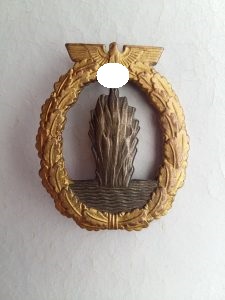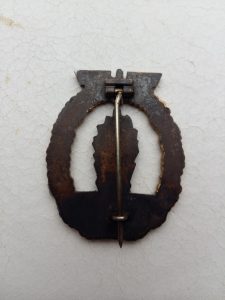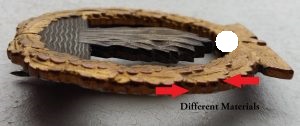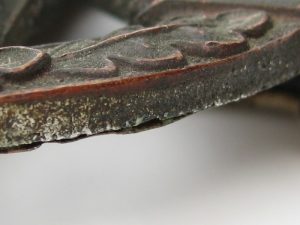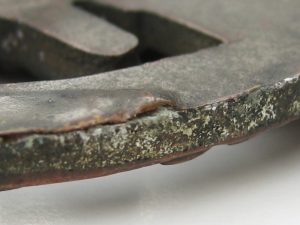Hi Gents, the days passing by and a lot of things happened in the world of collecting. Surfing trough the different areas of WAF, GCA and MFF I found very interesting items. Some are so interesting, that I asked the collectors if I can use the material for the BLOG…..Sometimes I get an answer and sometimes not. As you might know I am a little bit into cuff titles. On the MFF submerged a picture with a soldier wearing a special version of the Afrika cuff title on his sleeve. That one was the missing link….. I have that Afrika cuff title version in one of my books (and in my collection). Till that day there was no picture of that special cuff title on a uniform available and so nobody was sure if it was for tank crews or not. I asked the owner of the picture, Max Miller, if I can use it in my blog and he gave me a thumbs up!!
But let`s step back to the standard Afrika version first:
The cuff title Afrika was awarded by the Wehrmacht in World War II. It was founded by Adolf Hitler on January 15th, 1943. The cuff title Afrika should not be confused with the sleeve stripe „Afrika Korps“, which was awarded as a sign to all members of the German Afrika Korps.
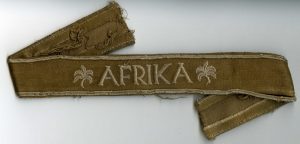
Creation date Army: January 15th, 1943
Creation date Navy: December 29th, 1942
Creation date Air Force: Jan. 28th, 1943
The cuff title Africa was awarded approximately 30,000 times. The awarding authority began from the battalion commander and the next higher ranking officer.
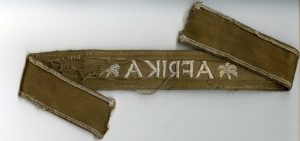
Closing date for the ceremony was October 31st, 1944.
3.1 Background
In February 1941, the German Afrika Korps (DAK) was formed in Libya within the “Operation Sunflower”. The DAK was created to stabilize the recent African campaign of the Italian troops and support them against the British army. From 1941, to October 1942, the DAK got hold of large parts of Libya, Tunisia and Egypt under Field Marshal Erwin Rommel. After that the DAK was stopped and driven back to El Alamein. In January 1943, the DAK had to clear Libya under the pressure from the Allies.The last German units in Africa capitulated May 13th, 1943.
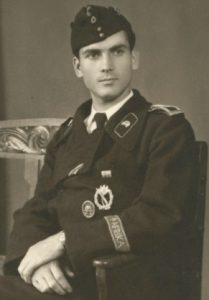
Basically the cuff title Africa could awarded to members of the armed forces, after the ceremony provisions of January 15th, 1943. Soldiers who served directly in the air, on land or at sea in Africa. Even members of the “Heeresgefolges” or in the immediate order of the army employed persons, also non-Wehrmacht soldiers who report to the Air Force or were active in their immediate contract, could be awarded.
Army
– Duty for six months on African soil
– Wounded in this operation
– Illness which led to the loss of full or conditional ability to serve in the tropicsice.
Navy
The same rules are applied in the Navy as in the army. For the crews of ships:
At least six months of operations at sea from bases in Africa.
Air force
For the Air Force were the same rules as in the Navy applied.
1st change of the provisions ceremony (Army on May 20th, 1943/ Air Force on July 1st, 1943). Members of the Army Group Africa, who took part in the final battle on African soil, on May 6th, 1943 honorably, the cuff title Afrika could be awarded after four months of service in Africa.
2nd change of the award provisions (December 14th, 1943)
The cuff title Afrika could now be awarded regardless of the operating time, provided that the soldier himself earned a bravery award during the fighting in Africa such as the Iron Cross, German Cross in Gold, mention in the Honor Roll,…
The cuff title (approximately 450 mm by 36 mm) was made of camel hair fabric. The lettering Afrika was mounted in white rayon embroidery centered. It has been enclosed on the top and bottom of the sleeve a strip of white is also about 3 mm wide strand. The cuff title Afrika was worn on the left forearm above the cuff.
Here it comes !
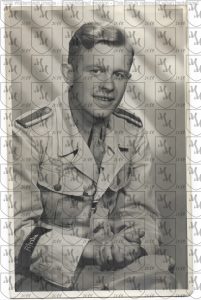
Finally we have the proff with the help of Max Miller that the black Afrika cuff title was a version used by the Luftwaffe and not by tank crews. An we have also proof that is a time period cuff title. Against the regulations but anyway used by some soldiers of the Luftwaffe.
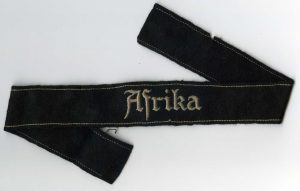
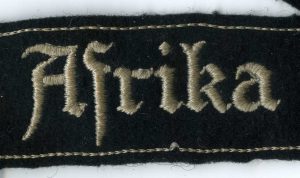
Sometimes it takes a little bit time but if you stay on it, some mysterys will be solved
If you like what your read, give me a like on Facebook
Take care
Best
Sascha
„Subscribe“ / „abonniere“
Copyright 2018 : Alle Rechte bei dem Verfasser Sascha Ulderup
